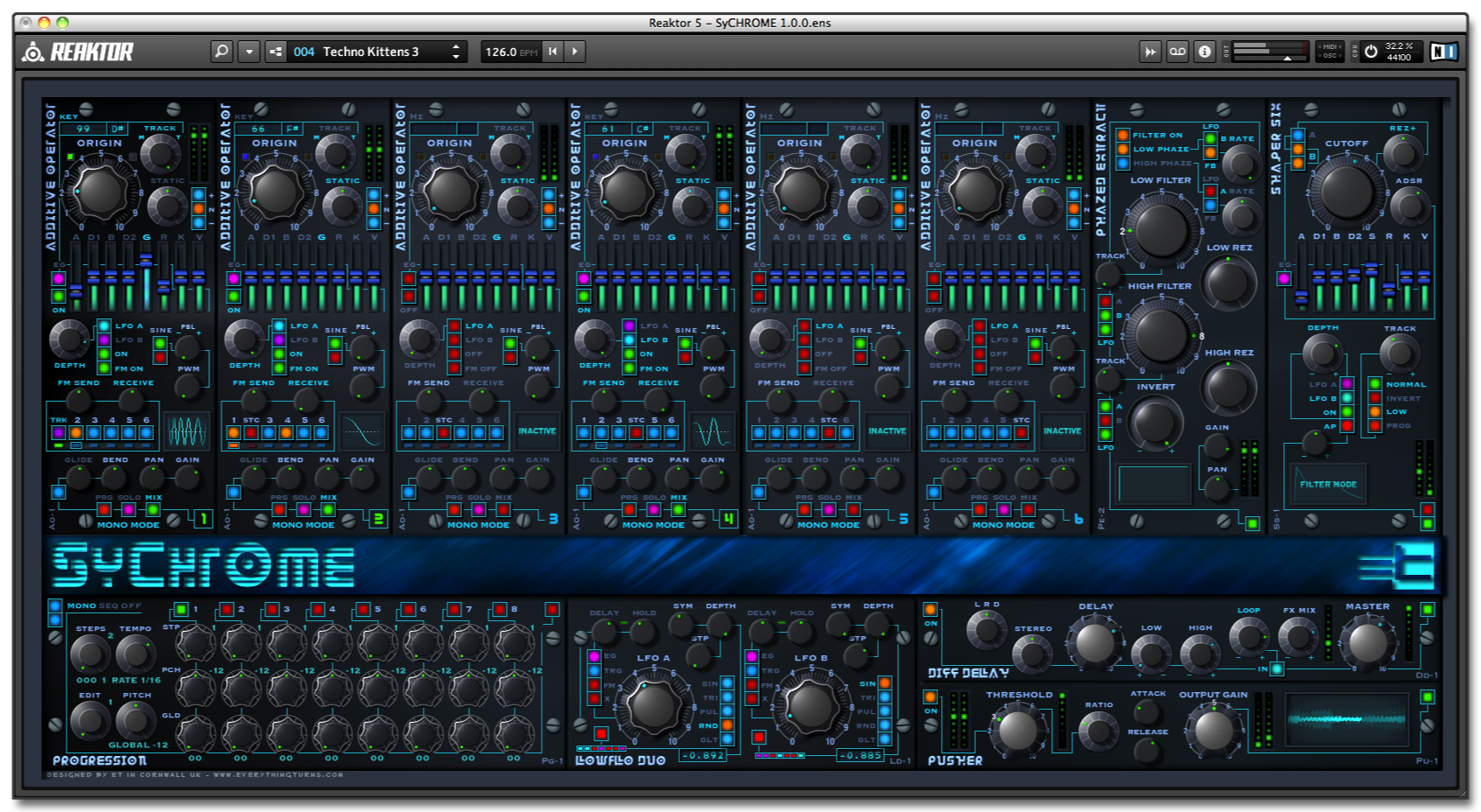
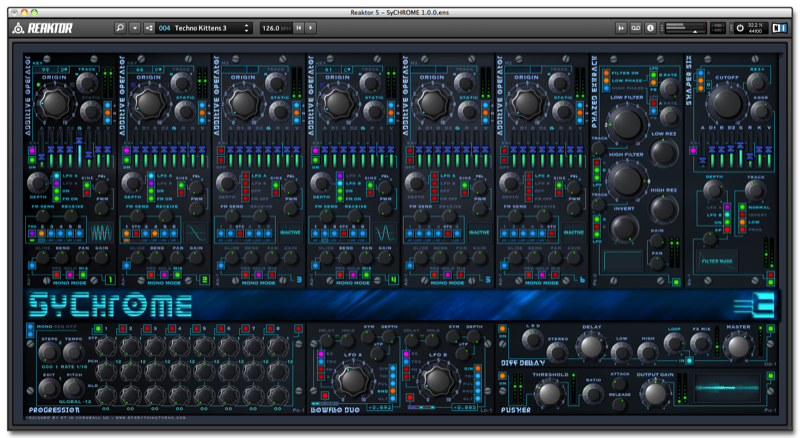
Aditive Operator
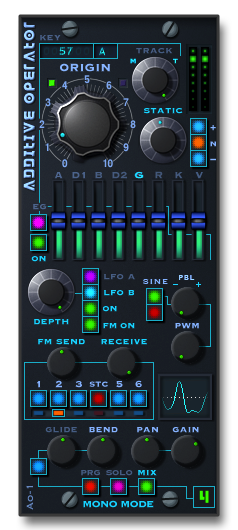
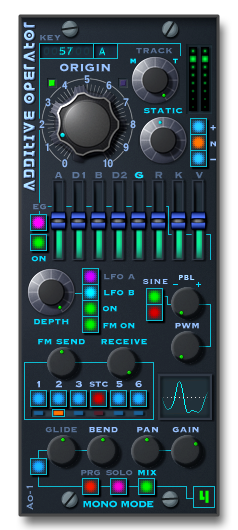
OPERATORS
Each operator has two waveform modes, Pure-Parabolic Sine or Triangle-Bipolar Pulse, the pure sine and triangle waves can be FM modulated, the parabolic and bipolar waves can be shaped by altering the waves symmetry and are not affected by FM.
In each mode the FM and none FM waveforms can be crossfaded allowing the fundamental frequency of the operator to remain present in the signal when producing extreme FM modulation.
Each of the 6 operators can be switched-into the main mix and also used as carrier/modulator at the same time, allowing very complex and diverse waveform generation.
The ORIGIN dial sets the base fundamental of the operator, the actual frequency produced depends on how the operator is responding to FM signals from the other operators and modulation, the dial is linked to the track and static dials.
The built-in tuner has three modes - Hz displays the frequency - KEY displays the midi note being received and EDIT displays the position of the dials.
The TRK/STC button in the FM Matrix section determines how the operator follows pitch generated via midi, when switched to TRK mode the operator responds to MIDI note data via the TRACK dial, rotating the dial to the far right will produce equal temperament, as you rotate the dial to the left the tuning space between each note will widen.
The OPERATOR EG alters the amplitude shape of the oscillator when it receives a gate signal.
The operator can be independently switched from MONO to POLY with the MODE switch below PRG-SOLO-MIX buttons.
Each operator has two waveform modes, Pure-Parabolic Sine or Triangle-Bipolar Pulse, the pure sine and triangle waves can be FM modulated, the parabolic and bipolar waves can be shaped by altering the waves symmetry and are not affected by FM.
In each mode the FM and none FM waveforms can be crossfaded allowing the fundamental frequency of the operator to remain present in the signal when producing extreme FM modulation.
Each of the 6 operators can be switched-into the main mix and also used as carrier/modulator at the same time, allowing very complex and diverse waveform generation.
The ORIGIN dial sets the base fundamental of the operator, the actual frequency produced depends on how the operator is responding to FM signals from the other operators and modulation, the dial is linked to the track and static dials.
The built-in tuner has three modes - Hz displays the frequency - KEY displays the midi note being received and EDIT displays the position of the dials.
The TRK/STC button in the FM Matrix section determines how the operator follows pitch generated via midi, when switched to TRK mode the operator responds to MIDI note data via the TRACK dial, rotating the dial to the far right will produce equal temperament, as you rotate the dial to the left the tuning space between each note will widen.
The OPERATOR EG alters the amplitude shape of the oscillator when it receives a gate signal.
The operator can be independently switched from MONO to POLY with the MODE switch below PRG-SOLO-MIX buttons.
Phazed Extract v2
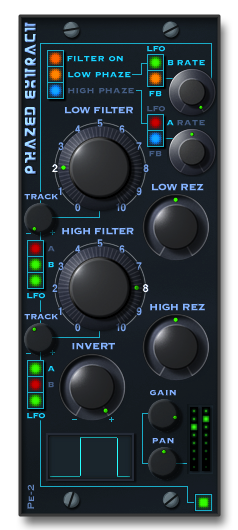
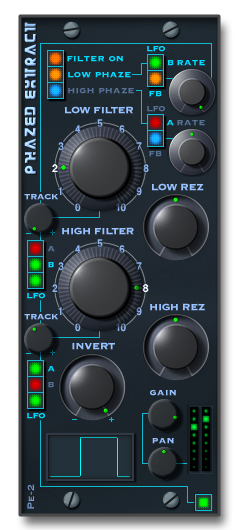
This is actually three separate processors that are independently switchable, first in line is Extract.
Extract is four 2-pole filters working against each other to produce a band-pass and a simultaneous band-reject filter, both with resonance, by adjusting the high and low dials the filters will create a band-pass state, the filters can be crossfaded over to produce a band-reject state filter.
The output of both the high and low filters are then passed onto two mono phasers each with its own extended LFO modulation and feedback control.
V2 adds MIDI key tracking and extended LFO modulation to the extract filters, plus output gain and pan.
Extract is four 2-pole filters working against each other to produce a band-pass and a simultaneous band-reject filter, both with resonance, by adjusting the high and low dials the filters will create a band-pass state, the filters can be crossfaded over to produce a band-reject state filter.
The output of both the high and low filters are then passed onto two mono phasers each with its own extended LFO modulation and feedback control.
V2 adds MIDI key tracking and extended LFO modulation to the extract filters, plus output gain and pan.
Shaper Six
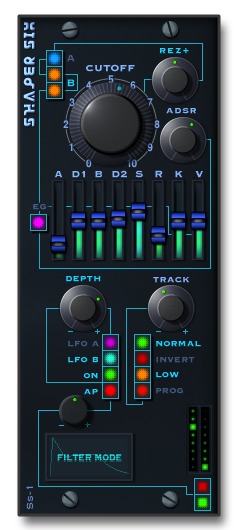
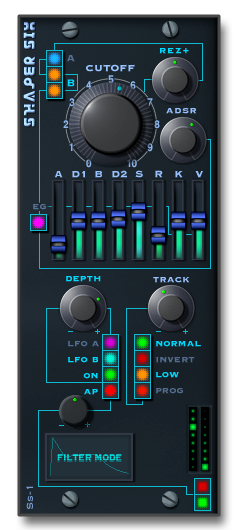
Shaper Six is a combined Multi-Mode Filter and EG (ADbdSR).
The EG receives gate and pitch via MIDI, when triggered it will follow the amplitude path set by the dials, the way it responds to gate and pitch depends on the settings of the K and V faders.
This is a six stage design with two decays and a variable slope.
The EG is also hard wired to the filters and will still have an effect when switched off. (i.e. not effecting the amplitude of the synth output but still effecting the filter)
Filter-A behaves as a 2x2 pole low-pass series design when in LOW mode producing a 4 pole 24db filter, when switched to High Mode the second stage of the filter changes to a 2 pole high-pass filter producing a high/band-pass effect.
Filter-B is a 4 pole low-pass design and is placed after Filter-A in series, Filter-B behaves differently to Filter-A producing a different tone, in addition to this the resonance can be switched to boost mode producing self-oscillation.
Boost has no effect on filter A.
Filters A and B can both be active at the same time producing an additional 8-pole 48db filter stage.
The filters can be set to follow key tracking using the TRACK dial.
In Normal Mode the filters will follow the EG positivity, opening and closing with the ADbdSR shape, by selecting Invert both filters will follow the EG in a negative way closing and opening with the ADbdSR shape.
Modulation of the cutoff frequency is set with the LFO DEPTH dial, the modulation receives it's signal from the LowFlow Duo.
AP (amplitude pan) will pan the outputs of the synth by altering the gain of the outputs and is dependent on the LFO signal.
PROG when switched-in receives it's signal from the PROGRESSION SEQUENCER.
The EG receives gate and pitch via MIDI, when triggered it will follow the amplitude path set by the dials, the way it responds to gate and pitch depends on the settings of the K and V faders.
This is a six stage design with two decays and a variable slope.
The EG is also hard wired to the filters and will still have an effect when switched off. (i.e. not effecting the amplitude of the synth output but still effecting the filter)
Filter-A behaves as a 2x2 pole low-pass series design when in LOW mode producing a 4 pole 24db filter, when switched to High Mode the second stage of the filter changes to a 2 pole high-pass filter producing a high/band-pass effect.
Filter-B is a 4 pole low-pass design and is placed after Filter-A in series, Filter-B behaves differently to Filter-A producing a different tone, in addition to this the resonance can be switched to boost mode producing self-oscillation.
Boost has no effect on filter A.
Filters A and B can both be active at the same time producing an additional 8-pole 48db filter stage.
The filters can be set to follow key tracking using the TRACK dial.
In Normal Mode the filters will follow the EG positivity, opening and closing with the ADbdSR shape, by selecting Invert both filters will follow the EG in a negative way closing and opening with the ADbdSR shape.
Modulation of the cutoff frequency is set with the LFO DEPTH dial, the modulation receives it's signal from the LowFlow Duo.
AP (amplitude pan) will pan the outputs of the synth by altering the gain of the outputs and is dependent on the LFO signal.
PROG when switched-in receives it's signal from the PROGRESSION SEQUENCER.
Lowflo Duo
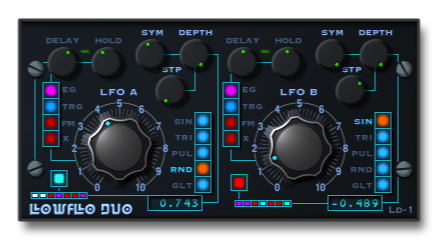
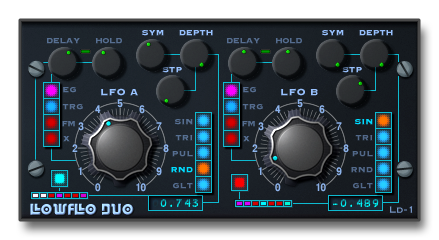
LowFlo Duo is a Multi-Wave LFO for adding modulation to the operators, it also has an effect on the cutoff of Shaper Six and the modulation of Phazed Extract, both LFO's work identical and can interact with each other producing complex modulation wave-forms.
When EG is activated the LFO passes through the DELAY and HOLD dials when each gate pulse is received.
The DELAY dial sets the amount of time that passes before the LFO modulation has an effect on the selected destination..
The HOLD dial sets the amount of time that the EG holds the LFO modulation before fading to zero.
TRG re-starts the LFO waveform with each gate pulse.
In FM mode each LFO will frequency modulate each other altering the LFO rate.
LFO-A modulates LFO-B and LFO-B modulates LFO-A, the FM modulation bus is sent through the DEPTH dials for fine tuning, both LFO outputs are available when in FM mode.
X-MOD will pitch modulate the LFO's.
The SYM dial (symmetry) alters the shape of the waveform shifting the waveform forward allowing the LFO to start with a positive or negative motion (pitch up or down).
GLT is only active when a midi note is received and is linked to the DELAY and HOLD dials even when deactivated.
When EG is activated the LFO passes through the DELAY and HOLD dials when each gate pulse is received.
The DELAY dial sets the amount of time that passes before the LFO modulation has an effect on the selected destination..
The HOLD dial sets the amount of time that the EG holds the LFO modulation before fading to zero.
TRG re-starts the LFO waveform with each gate pulse.
In FM mode each LFO will frequency modulate each other altering the LFO rate.
LFO-A modulates LFO-B and LFO-B modulates LFO-A, the FM modulation bus is sent through the DEPTH dials for fine tuning, both LFO outputs are available when in FM mode.
X-MOD will pitch modulate the LFO's.
The SYM dial (symmetry) alters the shape of the waveform shifting the waveform forward allowing the LFO to start with a positive or negative motion (pitch up or down).
GLT is only active when a midi note is received and is linked to the DELAY and HOLD dials even when deactivated.
Progression
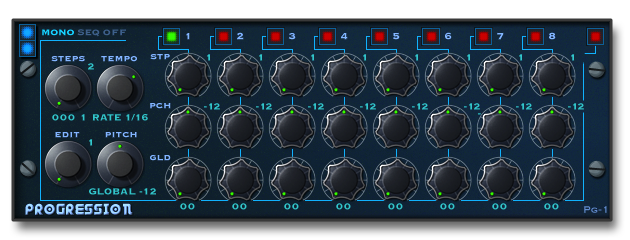
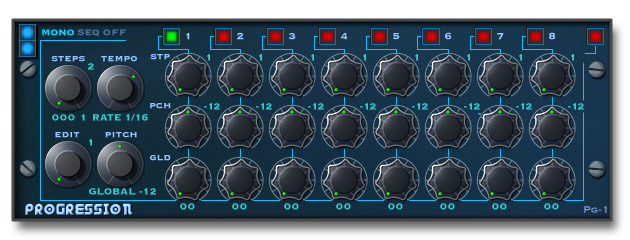
The PROGRESSION SEQUENCER is used to add changes to the pitch of the operators and the cutoff of the filters, this is an analog style sequencer and will automatically alter its step position as you change the dials, it works in mono and poly modes.
Each of the steps can be altered from 1 to 64 beats, giving you a maximin of 512 beats over the eight steps, the number of steps can be set from 2 to 8 and can be adjusted from whole note to a maximum of sixty fourths.
The GLD dials when used will glide the pitch of the sequencer steps.
The Sequencer clock can be bypassed and any step can be selected with the EDIT dial, this is handy when checking how steps with a high number of beats are altering the pitch of the operators without having to wait for the sequencer to circle back each time.
Each of the steps can be altered from 1 to 64 beats, giving you a maximin of 512 beats over the eight steps, the number of steps can be set from 2 to 8 and can be adjusted from whole note to a maximum of sixty fourths.
The GLD dials when used will glide the pitch of the sequencer steps.
The Sequencer clock can be bypassed and any step can be selected with the EDIT dial, this is handy when checking how steps with a high number of beats are altering the pitch of the operators without having to wait for the sequencer to circle back each time.
Diff Delay


The delay uses 8 diffusers to produce stereo delay and reverb effects with switchable feedback regeneration plus low and high filters in the feedback chain.
The Master dial is a separate processor that utilises a fast response limiter for setting the output gain of the synth.
The Master dial is a separate processor that utilises a fast response limiter for setting the output gain of the synth.
Pusher


The THRESHOLD dial sets the level the signal will reach before compression is applied.
RATIO adjusts the amount of compression being applied to the signal and is linked to the ATTACK and RELEASE dials.
OUTPUT GAIN sets the output level of the compressor before the limiter circuit at the end of the chain, the limiter will activate automatically.
RATIO adjusts the amount of compression being applied to the signal and is linked to the ATTACK and RELEASE dials.
OUTPUT GAIN sets the output level of the compressor before the limiter circuit at the end of the chain, the limiter will activate automatically.